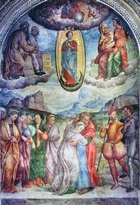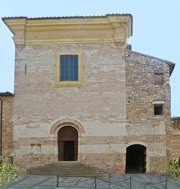
According to tradition, San Romualdo founded a church here, which is first documented in 1025 as a possession of the Abbazia di San Silvestro at Collepino. By the 13th century, the monks also owned an adjacent palace which seems to have served as a base for them in Spello.
In 1236, Pope Gregory IX ordered Bishop Bartolomeo Accoramboni of Spoleto to suppress San Silvestro, at which much of its property, including the complex of Sant’ Andrea, passed to the diocese. Bishop Bartolomeo entrusted this to three priests. However, the monks of San Sylvestro managed to return in in ca. 1253, and began to press their claim on Sant’ Andrea. Bishop Bartolomeo therefore found it expedient to transfer the complex to the Franciscans. The three priests agreed on condition that they continued to enjoy the revenues to which they had been entitled while being absolved from their previous pastoral responsibilities. Pope Innocent IV confirmed this transfer in 1254, at the request of his secretary, Menco da Spello, Bishop of Sutri. By this time, the Franciscans were already in place: a legal document was signed in 1253 “in palatio S. Andrea, ubi fratres minores morantur” (in the palace of Sant’ Andrea, where the friars minor live). Sant’ Andrea thus became one of the earliest parish churches to be administered by the Franciscans.
The Franciscans soon built a new church. Pope Alexander IV granted indulgences to those visiting it on the feast days of SS Francis and Clare in 1256 and again in 1258. Similar privileges were granted by Pope Nicholas IV in 1291.
In 1564, he friars of Sant’ Andrea asked their Provincial Minister to recover the relics of the Blessed Andrew Caccioli, one of the early companions of St Francis, whom they believed lay buried near the pulpit, under an ancient image of the Madonna and Child with SS John and Andrew, with a figure believed to have been the Blessed Andrew below. The friars called for Ascensidonio Spacca, il Fantino, who was at work in the Oratorio di San Giacomo, so that he could make a sketch of the image before it was destroyed in order to facilitate the recovery of the relics. An ancient coffin containing an entire skeleton was duly found. The relics of the Blessed Andrew were translated to the altar in the left transept (see below) three years later.
In 1656,when the order of the Crociferi was suppressed, their church of San Ventura was entrusted to the Franciscans of Sant’ Andrea.
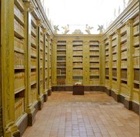
The Franciscans bought back the 1st floor of the convent (to the left of the church) in 1982, and began the restoration of the church.
Exterior
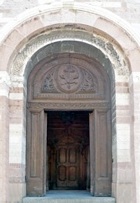
The smaller portal to the right leads to the atrium of the ex-convent.
The upper part of the facade was re-modeled in the late 17th century. Its earlier appearance can probably be seen in a fresco in San Ventura, in which the Blessed Andrew Caccioli revives a dead man outside a church. The lower part of the facade of this church is clearly modeled in Sant’ Andrea, but the upper part does not articulate the atrium to the right: a single facade embraces both portals. Its upper part has a central rose window below a triangular pediment.
Interior
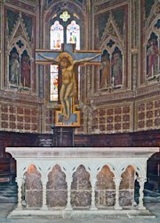
The interior is in the form of a Latin cross with a single nave.
Its apse was added in the 14th century, and the high altar, with 12 Gothic columns, dates to this period. The neo-Gothic frescoes (1913) of the Apostles behind it are are by Benvenuto Crispoldi.
Christus Patiens with St Francis (ca. 1290)
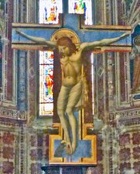
The Crucifix is generally accepted as the work of an Umbrian follower of Giotto, but opinions vary as to his identity. It is probably safest to refer to him simply as the Maestro della Crocifisso di Spello, albeit that no other work is attributed to him.
Madonna and child (13th century)
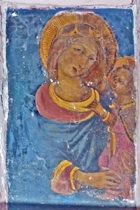
St Augustine (ca. 1460)
This fresco is in the vault of the Cappella del Beato Andrea, which is reached from the Cappella del sacramento (the 2nd opening on the left). It is attributed to Pietro di Giovanni Mazzaforte or his workshop. [This chapel was closed during my visit in 2010]
Madonna and Child with saints (1506-10)
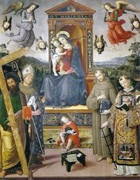
Pintoricchio continued to take responsibility for the commission:
-
✴he returned to Spello in 1508 to paint the most important parts of the main panel, albeit that he was soon called back to Siena (see below); and
-
✴in 1510, he commissioned Giovanni Francesco Ciambella, il Fantasia to execute the frame to his design and painted a tondo of the Risen Christ that was inserted into it.
The local historian Fausto Gentile Donnola documented the altarpiece on the high altar in ca. 1621. His description is the only surviving record of its predella, which contained small but exquisite scenes from the Passion of Christ. The original frame and most of the panels from the predella were lost, probably when the main panel was moved to its current location.
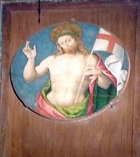
The panel depicts the Madonna and Child enthroned, with SS Andrew, Louis of Toulouse, Francis and Laurence, set against a landscape. Angels flank the throne and the young St John the Baptist sits on the steps below it. The document on the small table in the foreground reproduces part of the text of a letter that Bishop Gentile Baglioni of Orvieto wrote to Pintoricchio in 1508, begging him to return to Siena, where Pandolfo Petrucci awaited him. (Pandolfo, sometimes called the Magnificent, was in effect the Lord of Siena and Pintoricchio was involved in the frescoes for his palace there while the Spello commission was underway).
The panel was restored in 1971.
Madonna and Child with saints (1532)
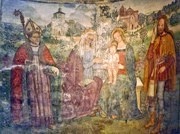
This fresco in the Cappella di Sant’ Anna (the 1st on the right) depicts the Madonna and Child enthroned with SS Nicholas of Bari, Anne and Roch. It was the work of Tommaso Corbo, who mentioned it in his will.
Virgin and St Joseph (1565)
Altare del Beato Andrea
As noted above, most of the relics of the Blessed Andrew Caccioli were translated to this altar in the left transept on 3rd June 1597. The Commune commissioned:
-
✴a silver reliquary (1603) for the head of the Blessed Andrew (which is dated by inscription); [where is it now ?]
-
✴the rebuilding of the Altare del Beato Andrea and the gilded wooden reliquary that still adorns it in 1609; and
-
✴the altarpiece of a miracle of the Blessed Andrew.
Miracle of the Blessed Andrew Caccioli (ca. 1610)
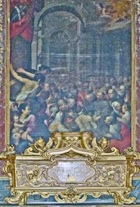
Cappella del Salvatore
The Cappella del Salvatore (the 1st on the left), which now serves as the Baptistery, has its own page in this website.
Art no Longer Displayed
The following were not displayed in July 2010.
Frescoes in the left transept (14th century)
These two detached frescoes, which were discovered during a recent restoration, depict:
-
✴the Madonna and Child enthroned with two angels and SS Antony Abbot and James and two donors; and
-
✴the Madonna and Child with a donor, by a follower of Cola Petruccioli.
Panels (ca. 1700)
These panels on the counter-facade of Sant’ Andrea, which are attributed to Carlo Lamparelli depict:
-
✴the Immaculate Virgin with angels; and
-
✴a portrait of a prelate (self-portrait?).






